It's been over two months since our last post, during that time we've been forced to put Peanut into quarantine. We submitted and received a request for public records regarding her case, and reached out directly to some new public officials.
Special thanks to everyone who's helped spread the word about Peanut's story, and signed our petition.
Updates
-
Peanut is now in rabies quarantine, at Cole Park Veterinary Hospital, in Chapel Hill, NC. She's tolerating her stay relatively well considering the circumstances. She's being treated for her heartworms. Everyone at Cole Park knows her and they all say she's a sweetheart and doing great. She'll be released on April 11th, 2015. It's still possible to get her released early.
-
We made a public records request . We received over 500 pages of documents, which have given us some new insight.
-
We've taken down the gofundme, and are no longer accepting donations of any kind. We have raised enough money to cover 100% of Peanut's quarantine if she has to continue for the full 6 months. If we can get her out early, we will donate any remaining money to a worthy dog-related charity.
-
We reached out to the state public health vets in Florida and North Carolina. The response was annoying and dismissive (yet informative) in the case of North Carolina. We got a positive response from Florida, and some insight on how things are typically handled there.
-
We've tried to get a statement from the emergency vet we took Peanut to initially, and have been ignored so far. This has been going on for months, and it seems she hasn't talked to OCAS either. We've resorted to registered mail and hope to finally get a response, or compel her to contact OCAS in the next week or two. She was really great, it's saddening to think she isn't willing to help us.
Peering into what was being said behind the scenes has given us some context we didn't have, and some new avenues to explore. However, it's been, overall, a sobering experience.
The argument we've been making for months now is still valid. The CDC's opinion is known to all officials involved (and has been known for months). That opinion states that a 2-3 month period is sufficient for rabies symptoms to manifest. At this point, it's been well over 3 months since Peanut was injured.
The validity of the account JD Drawdy, the man who lost Peanut in Florida, gave to OCAS is now known (and documented below), but it's no longer relevant. It doesn't matter how Peanut was injured anymore. It doesn't matter that the emergency vet won't just tell anyone what she really thinks happened. It doesn't matter that wild hogs don't spread rabies. It doesn't matter that there is no actual evidence of how she was injured.
It doesn't matter that Florida law is more lenient and makes many more allowances for home quarantine. It doesn't matter that Hawaii, a rabies free zone, would have required a 4 month quarantine in the same circumstances, and as such, the 6 month requirement is not a standard practice.
It's all irrelevant in light of the CDC's opinion. Peanut is healthy, she's not showing signs of infection, and it's been over 3 months. This means the likelihood that she was exposed to rabies is even less reasonable than it was before.
Seriously, we don't care about what happened in the past - just let us bring her home, no hard feelings!
Peanut's Status
Peanut has been in quarantine since December 5th, 2014.
She's currently in the care of Cole Park Veterinary Hospital in Chapel Hill, North Carolina.
She's healthy, seems confused bummed out at times. She's developed some boredom-related chewing, but otherwise is in good shape. She's currently being treated for heartworms, and responding well to the treadment. We feel confident that she is being given excellent care. Everybody at Cole Park adores her - just like everyone else that's ever met her.
If we are unable to convince OCAS to change their minds, she will be released on April 11th, 2015.
Current Financial Situation
We're having trouble getting itemized bills from Cole Park. However, the estimates we've gotten so far tell us that we will be able to afford paying for Peanut's entire quarantine, if necessary.
We sincerely thank everyone who donated and got the word out!!!
We will be posting detailed records of how every dollar we raised was spent very soon - the main hold up has been getting actual bills from Cole Park. They've given us some estimates, which we will publish in lieu of itemized bills if we have to.
If we have any money left over, we will donate it to a worthy dog-related cause. Suggestions are welcome.
The Documents

|
|
500+ pages of mostly e-mails... we added the tabs, but they were nice enough to provide binder clips. |
When we went to OCAS to sign the transfer papers on December 5th, 2014, I submitted a request for public records. I asked for any veterinary records, and all e-mails pertaining to Peanut's case.
We got the documents the first week in January. I had asked for a PDF, but there were too many pages to fit into the scanning machine at OCAS, so they gave me hard copies. 500+ pages worth.
Findings aside, the process was straight forward. You can even make these requests yourself, online. OCAS filled the request within the 30 day time limit (we received the documents the first week of January, 2015), and were very nice about it.
The hardest part with going through the documents is that entire email threads were included for every single e-mail printed out, and from multiple accounts. So the same information occurs over and over again. Filtering through the redundant information has been difficult. This also caused information to loose some of its chronological context.
While output of this magnitude might appear comprehensive, it's woefully incomplete. There are many exchanges between people at OCAS and myself that are not represented. A lot of the e-mails were forwards of threads from one person to another, lacking the original source. Some responses were left out, so e-mail threads just seem to end. Some correspondence ended in voice mails, or phone calls, which are additional dead ends in a paper record.
I've scanned some of the particularly pertinent documents and provided commentary and analysis below. I may continue to scan additional documents - if anyone is interested in more scans, please let us know.
You can leaf through scans of the documents referenced below, and more, on flickr.
Key Findings
-
There is no record of Peanut being examined by a vet at OCAS. The conclusions they drew were based entirely on the vet records from the emergency vet in Florida (one line in particular), and Stacy's account of what she thought might have happened.
-
In spite of this, she was diagnosed with hook worms and given a de-worming agent without our knowledge or consent. They did inform us about the additional rabies shot after the fact, which was completely unnecessary. This is standard practice, but not telling us about everything that was going on with her health represents the unnecessary opacity of this process.
-
There's no record that OCAS ever attempted to reach out to the emergency vet we took Peanut to. A vet tech reached out to them and explained that quarantine was unnecessary, but they never connected with the vet, and didn't trust the tech's opinion. This week we've sent registered letters asking for more information from the vet once and for all; she was really great, it's weird that she's been dodging us and OCAS for months.
-
I reached out to the president of the Humane Society of North Carolina asking for help. They immediately contacted OCAS and any concern was deflected with statements that were not entirely representative of reality. I got no reply.
-
There are other officials involved that we didn't know about until just recently, of specific importance was the Public Health Director of Orange County, Dr. Colleen Bridger.
-
Thanks to the state public health vet of North Carolina, we now know, with statues to back it up, that said Public Health Director is the central authority in these matters.
-
The county commissioners were warned about our case. This seems to have defused any inquiry (at least from what we can see in the documents).
-
One of our general assembly representatives was contacted by a concerned citizen and they reached out to Bob Marotto directly. Our whole case was distilled into a non-issue.
-
At least one e-mail I received and previously published from Bob Marotto was actually written by a communications specialist. One version was possibly "too mushy for [Bob]".
-
The change.org petition had a bigger impact than we realized. A "peanut fact sheet" [page 1, page 2] and several form letters were circulated to people who called or wrote in about her case. The so-called "fact sheet" was full of factual errors. The most egregious of which was stating bluntly that Stacy gave up Peanut because she was allergic to her (this is so unbelievably untrue).
-
In many of those correspondences, OCAS was giving people the impression that Peanut was going to be released soon. They didn't say it directly, but they mentioned that they "finally" contacted the man who lost her and that they were looking for information, implying that information could change their mind.
-
Attempts at deflection seem to have been the primary focus of all communications. This is heartbreaking, since the county commissioners, the GA representative, the county manager, the humane society, and many other people could have done something about this - but they just didn't.
-
JD Drawdy, the man who lost Peanut in October, was indeed in contact with OCAS. He told them what happened the night she was lost. This is now documented in the public record, both by his initial e-mail reaching out to OCAS, and confirmed in a summary e-mail that was sent to him after he talked to one of the officers. (note we've censored Peanut's real name, since this actually validates Mr. Drawdy's claim of ownership now that we've found who we believe is Peanut's original owner - Mr. Drawdy has never mentioned it to us).
-
However, when pressed, it seems JD refused to comply with all of OCAS' demands. In particular, he wouldn't respond to the summary e-mail of what he said happened, nor would he send them a copy of his driver's license to prove his identity. Why OCAS is requiring such stringent proof is not well understood. The law uses the term "reasonable suspicion" ( GS 130A-197) - it doesn't take much to make this very shaky suspicion unreasonable.
-
OCAS talked to the state public health vet in Florida, who assured them that wild boar do not indeed spread rabies, and they would recommend an in-home observation period, not a strict medical quarantine.
-
OCAS, the Public Health Director, and several other key officials were aware of the CDC and Florida Public Health Vet opinions, yet no action was taken.
-
I asked about appeal - there was a discussion between Bob Marotto and the Manager Of Public Health about this - all I have in the correspondence is "perhaps we can talk ... about the way we'd like to respond to his request" - not exactly the "no appeal is provided in these cases" response he ended up sending me.
Document Analysis, or: The Story Of Peanut, In Paper Documentation Form
After going through the stack of documents several times, we've identified the documents that provide new information and context, and scanned them for inclusion here, alongside some analysis and thoughts about what's going on.
We'll walk through the documents in a quasi-narrative style. It's long, but comprehensive.
You can click on any thumbnail below to see the document in full-size. The document links will open in a new window.
Let's start with the event that initiated our ordeal: Stacy's initial e-mail to OCAS, asking for help with possibly finding Peanut a new home.
First, Stacy's side of the e-mail thread:
Here's OCAS' internal handling of her initial inquiry:
We've written about the initial contact Stacy made with OCAS before. She was having a severe allergic reaction to Peanut. She was self-medicating. We'd had Peanut for a little over a week and we didn't know for sure at the time if we planned to adopt her. If nothing else, we initially were planning to take care of any health problems and foster her until we could find her a proper "fur-ever home".
We were working on getting Peanut spayed that week, and beginning to explore treatment options for her heart worm infection.
I started a new job that week, and was out of town at a conference for two days while this all went down (Oct. 22nd and 23rd, 2014). I wasn't too far out - I was in Raleigh, NC, about 30 minutes away.
With starting my new job, and attending the conference, Stacy took point making all of the arrangements to try to get Peanut spayed, in spite of her allergies.
We had never rescued a dog before, and to be honest, we were in over our heads... just a tiny bit.
Stacy was referred to OCAS by some local rescues, as OCAS has a good reputation in those circles. As mentioned in the OCAS-side of this e-mail thread, Peanut's wound was healed. It's obvious to us now that, besides Stacy's account of how we found her, OCAS gathered little evidence to bring them to the conclusion that Peanut had been injured at all, let alone exposed to rabies.
This is significant; in spite of kind cooperation on our part, they've treated everything we've said to them as dubious, starting with our assertion that Peanut was treated by two competent veterinarians in Florida, they found to be healthy and not suspected of rabies exposure.
But here's the rub: if our assertion that Peanut was treated properly was suspect, then why would our account of her injury be any more credible?
Further, had they not known about her injury, they would not have pursued quarantine. This is a troubling thought, when any dog that OCAS finds with unknown vaccination history who is subsequently adopted out could have been injured in the recent past - yet they don't require such stringent quarantine of those animals.
What's the difference in Peanut's case? That we were up front about her history? Is this whole ordeal really just a punishment for honesty?
It turns out that the only correspondence that OCAS had with the vets we took Peanut to were to retrieve paper records:
Note that her rabies certificate seemed to be of no interest to them.
When we met with Irene Phipps, Animal Control Manager, the week after Stacy surrendered Peanut, she had previously obtained Peanut's records from Florida on October 21st. The scans we've posted here were from documents faxed to OCAS, you can see the date stamp on the top of each page. She insisted that because the emergency vet records said simply "wound unkn origin", and the vet records from the practice we took Peanut to get vaccinated 2 days later didn't mention her injury, that there was "reasonable suspicion" that she was exposed to rabies.
She contested that a strict 6 month medical quarantine was necessary, because it's what the CDC recommends. This attitude becomes more comical when you recall that some time later, I asked the CDC about this and they recommended a 2-3 month observation period.
If your recommendations are based on the CDC's opinion, then why wouldn't the CDC's opinion have any weight?
That meeting was our last in-person interaction with any of the concerned parties at OCAS regarding Peanut's case. Our interaction with Ms. Phipps was very negative and it set a very bad tone for the rest of our interactions with her organization. When we visited OCAS for paperwork and to see Peanut, Ms. Phipps was always indisposed - or running into an office when she saw us coming.
There is no record that OCAS ever reached out to get clarification on Peanut's vet records.
A vet tech by the name of Bridget reached out to OCAS urging them that quarantine was unnecessary, as evidenced by this "activity card":
We've also talked to Bridget - she was extremely upset by the way she was treated by the folks at OCAS. They told her that they wouldn't talk to someone who was "just a vet tech", and that since she wasn't an RDVM, that her opinion didn't matter.
The last we heard from her, she said she was going to talk to Director Marotto. I urged her to have the vet send us, or OCAS, a statement about Peanut's injury and why she didn't recommend rabies quarantine.
However, it didn't appear that OCAS made any effort to talk to the vet that saw Peanut, nor did she make an effort to connect with them.
From the documents we've obtained, it appears that had they gotten some sort of testimony from the emergency vet that saw Peanut, this whole fiasco would have ended days after it began.
Sadly, OCAS never bothered to convey this to us. We started exploring other options, in particular finding Peanut's owner, to try to prove how she was injured, or if we were extremely lucky, find evidence that she had been vaccinated for rabies.
We have family close to where the emergency vet practice is located - we assumed that they had outright rejected the emergency vet's testimony. We couldn't figure out why she decided she didn't want to help us, and why OCAS didn't inform us they couldn't get a hold of her is a mystery. It's sad to think that we were exploring other options when we could have put more effort into obtaining the vet's opinion.
OCAS has routinely avoided telling us what we could do to end this - this is really the first example of what became a pattern of opacity, suspicion, and lack of collaboration with us to do what's best for Peanut.
Backing up a bit, we've been able to obtain all of the forms that Stacy was forced to fill out when she was asked to surrender Peanut to OCAS on October 23rd, 2014. She did not receive any carbon copies of these forms. We posted about the confusion between a 10-day and 6-month quarantine with a cropped image of a carbon copy we obtained before. When I returned home from the conference that night and Stacy told me what happened, we obtained that carbon copy by returning to OCAS and asking the (then different) person at the front desk for it.
We found out later that they weren't supposed to release any documents to us after the fact without a public records request. We were fortunate that we got the one carbon copy at all.
My first instinct was to try to wrap my head around what happened by looking at what Stacy had signed, and I was shocked that she was not given a single carbon copy. It turns out there were a lot more forms filled out than Stacy could recall at the time (remember, this whole situation was extremely traumatic for her). Here are all of those forms in their entirety:
The lack of carbon copies and the fact that they showed Stacy one thing when she signed, and then changed the form after she left added to the bad tone that was already set for our interactions with OCAS.
Something we missed initially: on the first form above, they wrote in a "release date" of 10/28/2014. This is neither 10 days nor 6 months from the date the form was filled out. It's unclear what that date was supposed to mean.
Note that the two forms that dealt specifically with rabies were not filled out by Stacy (this is obvious from the different hand writing). They got the minimal information that Stacy was required to provide, her signature, and then filled the rest of the forms out when she wasn't present. This form was actually filled out on October 22nd when the OCAS officer visited our house, and the date was added after the fact to align with the rest of the documents.
It's easy see how upset this whole process made us. Look at how confusing the verbiage is on these forms. They make it sound like we were giving up all rights to Peanut, and that OCAS could put her down at their discretion. OCAS tried to tell us later that that wasn't the case - but I'm sure if it came to legal action, or if they had put her down, they'd cite the form as justification.
Stacy's asserted that she did NOT want to surrender Peanut, even on the surrender form. There's only one surrender form, and it's absolute. It's used for any transfer of an animal from a citizen to OCAS, regardless of the circumstances. It explicitly says that Stacy was giving up ownership of Peanut, and that placement and/or euthanasia could happen solely at OCAS' discretion.
It's frustrating when you look at how OCAS has spun our case, downplaying the possibility of euthanasia. This is in stark contrast to what the law says, what Ms. Phipps told us very bluntly when we met, and what the form says.
Our situation was not representative of a "fed up pet owner" giving up a dog they couldn't handle. It was obvious from the interactions with Stacy that she was horribly distressed, and she was adamant through the whole interaction that she did NOT WANT TO GIVE PEANUT UP.
The bad interactions with the forms, the way the animal control officer intimidated Stacy when he initially came out to our house to assess Peanut, our terrible experience with Ms. Phipps, and the way OCAS treated poor Bridget the vet tech made us extremely apprehensive about dealing with OCAS in general.
We surmised that the only thing that would satisfy OCAS would be evidence of prior vaccination. It was obvious that we couldn't rely on them to do this legwork, so we had to ramp up finding Peanut's original owner ourselves.
This is when I created flyers and put them out on Facebook. I posted to the Brevard Lost Pets (BLP) website, and made a new post on Craigslist. The BLP post drew the attention of a Mr JD Drawdy. The initial search is well documented in The Current (dire, complicated) Situation, and The Latest Resistance To Reason. What we didn't see was what exactly OCAS was asking of Mr. Drawdy and what he was saying to them.
OCAS tried the phone numbers I got from JD on November 14th, 2014 and couldn't connect. From the records, it doesn't seem they tried very hard.
He finally reached out to OCAS on November 28th, 2014, and OCAS immediately had trouble connecting with him:
Note that in my public records request, I was not given the original e-mail from Mr. Drawdy, only this response from Mr. Marotto that contained it. This is common throughout the records I received.
In Mr. Drawdy's correspondence, I've blacked out Peanut's real name - this is something I feel helps to certify that Mr. Drawdy is indeed the man who lost Peanut. I found out her name from a separate source - in spite of the fact that JD said he couldn't get in touch with the man he got Peanut from, I was able to track this gentleman down, and eventually, I found the man who originally owned her. We have not publicized this at all prior to this post, in the hopes that we could further corroborate Mr. Drawdy's story without the possibility of being accused that we fed him the information.
Eventually OCAS was able to get Mr. Drawdy on the phone. OCAS not tell me this. After some radio silence from Mr. Drawdy, he contacted me to inform me that he talked to OCAS - I emailed Bob Marotto right away, as we were narrowing in on a new deadline to get Peanut into quarantine. This is all documented in The Latest Resistance To Reason.
What I also didn't know, was what exactly they were asking Mr. Drawdy to do. They wanted him to confirm his story in an e-mail, and send them a copy of his driver's license. They gave up pretty quickly when he didn't comply.
It appears he never did what they asked. But what OCAS told us was that they were unable to get ahold of him. When I called them on this, they blew it off. They were more concerned with getting Peanut out of their facility than they were with the truth.
What's especially frustrating about all of this though, is that between the Facebook posts that I pointed out to them, and Mr. Drawdy's account, it seems like they're applying extremely rigorous standards for proof that Mr. Drawdy did indeed own, and was the one who lost, Peanut.
The statues that govern this situation are short, and terse. GS 130A-197 is the law that OCAS is trying to enforce by quarantining Peanut. This statute talks of "reasonable suspicion". This is well known to OCAS - in fact Bob Marotto, the Director, mentions this directly in early discussions about Peanut. How much information does it take to make suspicion of rabies unreasonable in Peanut's case?
As explained in The Latest Reisistence To Reason, we were forced to put Peanut into quarantine on December 5th, 2014. I submitted the information request the day we signed the transfer paperwork.
While we were waiting for the information request to be fulfilled, I reached out to the state public health vets in Florida and North Carolina (on December 30th, 2014).
It turns out that OCAS consulted the Florida state public health vet previously, on December 3rd:
The first two documents are requests from Bob Marotto to have someone contact the state public health vet in Florida, Dr. Danielle Stanek. He asks specifically about the concerns I raised, and cited the same information I provided to him. It seems this occurred over the phone. The response from Dr. Stanek, conveyed by Ashley Miller, the Training Lead Officer for OCAS, is exactly what I've been asserting all of this time: hog bites rarely if ever ("more of a 'theoretical' risk") cause rabies.
She states that Brucellosis is more of a concern, and that post-exposure prophylaxis (PEP) [it's not stated but I believe PEP here refers to rabies prophylaxis] is recommended, but typically not administered when a human is injured by a wild hog.
No human has contracted rabies in the state of Florida since 2004. Even in that case, this was an isolated incident, and the transmission was likely to have occurred in Hati (Rabies Prevention and Control in Florida, 2014, chapter 2). It's obvious that wild hog hunters are not being routinely infected, in spite of typically refusing PEP. This further supports the notion that a hog-related injury is severely unlikely to constitute rabies exposure.
Brucellosis suis, the swine variant of the Burcellosis-causing bacteria is endemic in Florida wild hog populations. It is one of the two most infections species of Brucellosis bacteria in humans. It is transmissible from wild pigs to dogs, as evidenced by a paper published in 2011 focused on hunting dogs in Georgia. That paper states that:
"Although transmission of B. suis from dogs to humans has not been reported, B. suis is second only to B. melitensis in its pathogenicity to humans. [...] Given the serious zoonotic implications of B. suis infections, euthanasia of the affected pet may be advocated by regulatory agencies and physicians treating exposed humans.
Since Brucellosis is of a higer concern for Dr. Stanek than rabies, lets compare the two diseases.
Rabies cannot be transmitted (except under extreme conditions) until the animal shows symptoms - the virus works its way from the blood to the spinal column, and eventually into the brain. From there it's "shed" into the saliva as the brain damage causes the dog to act atypically, usually showing increased aggression. This is why quarantine is warranted when an animal may have been exposed to rabies, but the source of that exposure is not available for study - if you wait, and the dog doesn't get sick, then the dog is probably not infected.
Brucellosis is communicable as soon as an animal is infected. It chiefly interrupts the reproductive functions in dogs, so if an animal isn't breeding or has been neutered, it's possible to harbor and spread the disease without manifesting symptoms. Even in intact dogs, they can show no signs at all and still spread the infection to other dogs, other domestic animals, and possibly humans.
Granted, the chief way Brucellosis is spread to humans "through contact with placental tissues or vaginal secretions from infected animals (and to a lesser degree because of contact with blood or urine)" [source], and as quoted above, has not yet been observed. But it's still highly communicable, and causes severe disease. There is no cure in dogs, and for human infection, it can be extremely difficult to fight with antibiotics, causes life-long disability and death.
Rabies is typically spread through a bite.
However, no quarantine will protect the public from Brucellosis. This is cause for concern because even after we asserted that Peanut was used for hunting feral hogs in Florida, where B. suis is endemic, OCAS did not call for a blood test to determine if she's been infected.
If she were infected with Brucellosis, we would most likely be forced to put her down.
NOTE: Although we find it highly unlikely that she was exposed, now that we're fully aware of the severity of this disease, we are going to get Peanut tested ASAP.
This is all unpleasant to think about, but there's a point: why neglect to test for Brucellosis, a disease where exposure is probable, a dangerous disease that is highly communicable, while vehemently insisting that quarantine for rabies, exposure to which is very improbable, is necessary?
This flies in the face of the "better safe than sorry" logic that OCAS has been using to justify their actions. We could assume OCAS was just ignorant of the potential for B. suis exposure, but given their conversation with Dr. Stanek in early December, ignorance is no excuse. If they had concern of exposure and somehow ruled it out, there's no evidence of this.
Dr. Stanek suggested an "'informal' type quarantine where the dog would be monitored in a home environment". This is what we asked for early on - it was quickly denied. This is significant, since we've been told again and again that the way OCAS has been handling things is congruent with how it's handled in other states. This is an incorrect assumption. It may be common practice in some states, even most states, but what Florida does is especially important, since that's where we found her, that's where she was injured, and that's where we complied with the local law and regulations prior to bringing Peanut into North Carolina.
In the final document, we see Director Marotto telling the Public Health Manager, Colleen Bridger, "I'll give you a call later to talk about options in light of the following", referencing the opinion of Dr. Stanek.
There's no discussion in the public records I obtained about what "options" Mr. Marotto was referring to. This conversation happened just days before we were forced to put Peanut into quarantine.
Unaware of this interaction, on December 30th, 2014, I also independently reached out to the state public health vet in Florida, Dr.Carina Blackmore as well as the interim state public health vet in North Carolina, Dr. Carl Williams.
You may be wondering what the relationship is between Dr. Carina Blackmore, who I emailed, and Dr. Danielle Stanek, who OCAS reached out to. Both are doctors of veterinary medicine with specialties in epidemiology, and work at the Florida Department of Health. I had trouble finding exact titles for both doctors, but it is safe to say they are both "state public health veterinarians" who work closely together to advise the Florida Department of Health.
There's some overlap between my inquires to the state public health vets.
In my correspondence with Dr. Blackmore, she connected me with Dr. Williams, unaware I had reached out to him on my own. Since then I've carbon copied everyone in both states on any further inquiries or responses.
Here's my initial inquiry to Dr. Blackmore, her response, and Dr. Williams' comments:
A few interesting take-aways from this exchange:
-
Dr. Blackmore was very kind. It was refreshing to deal with a public official who showed genuine concern and wasn't playing politics.
-
Dr. Blackmore reiterated what Dr. Stanek had said to OCAS previously about feral hogs not being a rabies risk.
-
There is an emerging mythology here that is jumped on by OCAS and Dr. Williams, the NC state public health vet: the notion that a raccoon could have injured Peanut. This is not physically possible. The location and nature of her wound was not congruent with a raccoon attack. No one has ever suggested that she was injured by a raccoon until now.
-
It seems state public health vets all know each other. Besides common interests, this is likely because of involvement with the National Association of State Veterinarians.
-
Dr. Williams takes issue with the fact that we didn't just dump Peanut in a shelter in Florida, implying that a week would have been more than adequate time to do so.
I want to address the last bullet point in some detail. First I want to address the flippant attitude he expresses, which seems to be common amongst the people we've dealt with in the North Carolina government.
We are continually treated like we're a "typical" rabies exposure case in North Carolina (note I'm being a tiny bit sarcastic here): someone didn't bother to get their dog its shots. They let it roam around off a leash, and ultimately it gets in a fight with an opossum or fox or raccoon. The owner takes the dog to a vet for treatment. The vet, under obligation of law, calls animal control and reports possible exposure. Animal control can't find record of the dog's rabies vaccination, so it's impounded and either destroyed or put into quarantine. The citizen raises a fuss, but you know, they should have been a better dog owner and had their dog vaccinated, and kept a better eye on it, so they got what they deserve. It's better for everyone that this person with poor pet ownership skills is treated this way to protect the rest of us.
OCAS assured us that suspected rabies exposure leading to quarantine happens all the time, as if having a rabies problem in Orange County was routine, and that this blanket application of quarantine authority isn't actually helping.
Peanut's case is extremely atypical, and they refuse to accept that. She was a hunting dog, injured in the course of her work. She was found in Florida. She was treated, vaccinated (with a proper certificate to prove it) and fully healed when she was transported to North Carolina.
All procedures and laws were adhered to in Florida. By all rights, her history in North Carolina started the day we crossed the border on our way home.
OCAS didn't find her roaming the streets; she didn't have gaping wounds when we brought her into Orange County - she was healed, healthy, vaccinated to the nines, and in a good home.
No vet examined Peanut and found her to be suspect of exposure to rabies, in Florida or North Carolina.
But because Stacy reached out for help out of nothing but concern for the well being of Peanut, she was lumped in with every (more sarcasm here) "irresponsible" pet owner that OCAS has ever dealt with. All of the vaccination refusers, the tax evaders, and dead beats who get a dog and can't handle the responsibility.
Side note for the uninitiated: Orange County charges taxes on pets. They know you have a pet, because they require registration of all rabies vaccinations. Once you get the tag, you get taxed. In the 2012-2013 fiscal year, they collected 20,600 license fees, amounting to over $600,000 in gross income [source (page 55)].
If feels cynical to say, but that seems to be the source of their suspicion. Stacy and I are reduced to stereotypes of the worst of the citizens OCAS interacts with and feel somehow superior to. And that, for unknown reasons, makes us worthy of suspicion.
It's almost like, because we stood up and asked questions, regardless of how upfront, honest and cooperative we've been, gives them reason to think they can't work with us to help Peanut. It's ridiculous.
This suspicious attitude is subtle, but it runs thorough all of the documents we've found, and our personal interactions. From Irene Phipps trying "not to sound cynical" as she questions Stacy's credibility, to the erroneous "fact sheet" that states Stacy was "unable to keep [Peanut] due to allergies", to the snowballing tactics in every e-mail I've ever gotten from Director Bob Marotto, it seems to be endemic. Frankly, as a proud citizen of Orange County and North Carolina, it just sucks to be treated this way. I cringe to think my tax dollars - I own property in Orange County, by the way, and pay a premium in taxes for the privilege of living here - are paying the salaries of people who treat us with contempt like this.
Disrespect and poor treatment of concerned citizens aside, let me get back to addressing the notion that "it's curious that, with one week left on his vacation, he could not find an Animal Services agency to take custody of the dog..." raised by Dr. Williams.
We found Peanut on a Saturday (October 11th, 2014), exactly one week before we planned to leave Florida to return to North Carolina. We did indeed reach out to one of the Brevard County Animal Services shelters when we initially found her, via a park ranger who was assisting us. They were unable to respond right away, and couldn't tell us when they'd be able to help.
We couldn't wait for them. Peanut was sitting in direct sunlight, refusing to move, and wouldn't drink the water we gave her. She was obviously injured but we couldn't tell to what extent. We had to do something for her. It was at that moment that we decided that Peanut was our responsibility, and made an effort to get her out of the situation she was in so we could take her to the emergency vet. We were surprised and delighted when she suddenly stood up and let us put her in our car - this gave us a glimpse of her temperment, and meant that her injury was minor.
Brevard County's Animal Services had changed hands to the Sherrif's Office just prior to our visit to Florida. I wasn't aware of this at the time. I grew up in Brevard County and the previous agency (Brevard Animal Services & Enforcement) had a terrible reputation. Part of the motivation for the transfer to control of these duties to the Sherrif's Office was a scathing report issued by the County Clerk's Office that found the organization routinely broke the law, including unjustfied euthanasia. Having no idea that the shelters had changed hands, I didn't know that BCAS might have been able to actually help Peanut. However, their shelters still routinely put animals down.
There are several no-kill shelters in Brevard County, but none have open admission policies. The ones we contacted would not take surrenders from individuals. If we wanted Peanut to end up in one of these shelters, or a rescue, we would have had to take her to a BCAS shelter, and hope for the best. We were not prepared to take that risk.
It takes time to take a dog to the vet. We couldn't get Peanut in to see anyone for her vaccinations and heart worm test until Tuesday, October 14th.
We had a hard deadline to get back to North Carolina by Monday, October 20th. I was starting a new job. This meant that we couldn't extend our stay in Florida to give us more time to figure out what to do with Peanut.
The fact of the matter is, we really only had 3 full days that week to do anything.
A week may seem like a long time, I guess, but the reality of the situation is that it's just not reasonable to think we could have done much more than we did. I suppose we could have, as Dr. Williams seems to have preferred, just taken Peanut to the BCAS shelter within that time frame. But the second we put her in our car, her welfare became our responsibility. This is something we do not take lightly. Dumping her in a shelter would have meant shirking our obligation to this sweet dog, and ultimately putting her at risk.
It's so offensive for me to think that the fact that we didn't just dump Peanut in a shelter gave Dr. Williams a sense of suspicion, but what's worse, is he expresses this attitude behind closed doors, and no one ever asked us about it. We could have clarified what happened, maybe put that suspicion to rest, but they couldn't be bothered with the truth.
In any case, the state public health vets were in contact at this point, as evidenced by the email thread above.
On December 30th, 2014, the same day I reached out to the Dr. Blackmore, I also separately e-mailed Dr. Williams. I wasn't expecting them to know each other, or I would have just e-mailed them all at once.
Here's that entire thread. Note that it was forwarded to Annette Moore, staff attorney for Orange County by Bob Marotto, the Director. It's unclear if this thread went any further, as the information request only contained documents through the end of 2014. I did not see any e-mails originating from Ms. Moore in the documents that were given to me.
Most of my e-mail to Dr. Williams was well-established background information. The key part was where I stated the CDC opinion:
Since the breakdown in communication between the person who lost Peanut and OCAS, I contacted the CDC to get their take (the full content of that e-mail is pasted below).
They told me that dogs typically manifest rabies 2-3 months after injury. They said that pigs rarely contract rabies (although it is possible) and that rabies has not been reported in pigs in the state of Florida for many years (looking at the stats from the state, it hasn't happened since 1969[1]). Further, a pig defending itself against an attacking dog would be considered normal behavior, not indicative of a sick animal.
At that point, there is no longer a "reasonable suspicion", as described in the law, that this animal was exposed to rabies, at least in my non-expert opinion.
However, the 2-3 month timeline mentioned is significant. Even if we don't believe the man who lost the dog, or still feel that she may have been injured by some other rabid animal (ignoring the nature of her wound and the fact that 0 cases of rabies were reported YTD in the area before she was injured[2]), the CDC is telling us that 2-3 months is sufficient for her to show signs of infection.
On January 11th, 2015, it will be 3 full months since she was injured. At that point, further quarantine would be unnecessary.
I don't think I could have stated this any more clearly.
Dr. Williams did not read my statements carefully, and was dismissive in his lengthy response.
He starts off trying to tell me that animals are possibly exposed to rabies all the time in North Carolina, and that he and Director Marotto have a long history:
Sir,
Thank you for your correspondence and I will try to address some of the issues you have raised. I have known Mr. Marotto for many years and have spoken with him about this case as well as many other similar situations. Potential exposures of dogs and cats to rabies are quite common throughout North Carolina and often necessitate the application of control measures.
He ignores the fact that Peanut was injured in Florida, and jumps right into schooling me in the ways of the general statues, starting with establishing authority to "necessitate the application of control measures":
Let me begin by outlining the authority for rabies control in NC. Due to the serious nature of rabies it is one of the only infectious conditions with specific general statutes written for it. The NC General Statutes (130A-41) stipulate that the Local Health Director has the authority to examine, investigate and control rabies. This authority may be delegated per NCGS 130A-6 and often many aspects of rabies control are delegated to local animal services agencies. Local government agencies are then expected to enforce the statewide rabies laws. NCGS 130A-197 is the law that specifically covers the quarantine required for dogs, cats or ferrets that have been exposed (or are reasonably suspected of being exposed) to rabies. The incubation period for rabies in the dog may range anywhere from three weeks to six months. Because the incubation period can extend up to six months the NC rabies control laws are written to require a up to six month quarantine. I mention this because the authority for rabies control is often misunderstood, but is delineated by North Carolina law.
He is careful to mention the "reasonable suspicion" clause (GS 130A-197), which is the entire basis of my argument. When faced with multiple, credible reasons not to suspect rabies exposure, statute 130A-197 simply falls down. If you try to assert that reason itself can be subjective, it's only subjective to a point before it becomes a complete fallacy - and that's a very short trip.
He explains how authority is granted to the "local health director", and delegated to other people.
Here is the text of GS 130A-41, with regards to authority:
I don't think anyone would dispute this statute. This allows the "local health director" the authority to enforce the laws with regard to public health. This is a good thing! This authority can also be delegated, as Dr. Williams helpfully points out by citing GS 130A-6. I respect that authority, but how is telling me that addressing my concerns?
In our case, that person is Dr. Colleen M Bridger and she has delegated this responsibility to OCAS, Bob Marotto in particular.
The law doesn't say, however, that delegation means that you've absolved yourself of your authority. I believe this is what Dr. Williams is trying to imply. That somehow, because Dr. Bridger has delegated authority to OCAS, that she can no longer exercise it. This is not sound logic, and ultimately irrelevant, because any of these people (the Director of Public Heath, and her delegates) are subject to 130A-6, and any of them can decide what a "reasonable suspicion" is.
He further implicates that the law is absolute and not open to application at the discretion of the public health director. This is refuted by the very statutes that are cited.
Interestingly, the statute also states:
"Nothing in this paragraph shall be construed to abrogate the authority of the board of county commissioners."
I believe what that means, is that the county commissioners have authority over Dr. Bridger. This might explain why they were quickly whitewashed as the public outcry intensified - which we will get to shortly.
Here is the full text of GS 130-A-197, which states explicitly the parameters under which a rabies quarantine is warranted:
§ 130A-197. Infected animals to be destroyed; protection of vaccinated animals.When the local health director reasonably suspects that an animal required to be vaccinated under this Part has been exposed to the saliva or nervous tissue of a proven rabid animal or animal reasonably suspected of having rabies that is not available for laboratory diagnosis, the animal shall be considered to have been exposed to rabies. An animal exposed to rabies shall be destroyed immediately by its owner, the county Animal Control Officer or a peace officer unless the animal has been vaccinated against rabies in accordance with this Part and the rules of the Commission more than 28 days prior to being exposed, and is given a booster dose of rabies vaccine within five days of the exposure. As an alternative to destruction, the animal may be quarantined at a facility approved by the local health director for a period up to six months, and under reasonable conditions imposed by the local health director. (1935, c. 122, s. 14; 1953, c. 876, s. 10; 1983, c. 891, s. 2; 2000-163, s. 4; 2009-327, s. 12.)
What this means is that Dr. Williams' words are saying a lot but not making any real argument. What he's told me here, by the statues he cites, is that it's not his responsibility to make this decision. If anything, what he's told me in this first paragraph is that he could compel Dr. Bridger, Mr. Marotto, or Ms. Phipps if he had the desire to do so. But he has no real authority here, and the folks who do are held to the standard of "reasonable suspicion" outlined in 130A-197.
Next, he tries to bamboozle me with a UNC School of Government interpretation of the law, that honestly doesn't provide any new information (it is a nice write up however), trying to address the common confusion between a rabies quarantine and observation after a dog bite:
The location and conditions of the six month confinement are determined by the local authorities but are generally at a veterinary clinic or hospital. Per a legal interpretation of the rabies quarantine law by the UNC SOG ( http://www.sog.unc.edu/node/255): "unlike the statute related to confinement of biting animals [130A-196], this statute [130A-197] does not specifically authorize the health director to allow the animal to be confined on the owner's property. In addition, the quarantine statute refers to a "facility" rather than a "place" designated by the local health director. Based on this word choice and the omission of a direct reference to home quarantine, one could infer that the health director is not authorized to allow the animal to be quarantined on the owner's property for this six-month period. This interpretation would be consistent with a recommendation from the National Association of State Public Health Veterinarians (NASPHV) that exposed, unvaccinated animals "be placed in strict isolation for 6 months, which means "confinement in an enclosure that precludes direct contact with people and other animals." It is therefore the standard practice of many, if not all, animal services agencies across the state to require a six month confinement at a facility when there is a suspected exposure to rabies and the dog or cat is not currently vaccinated against rabies, or the rabies vaccination status is unknown.
It's important to note that we did ask for home quarantine as an early option. It would have saved Peanut any undue stress and eliminated the financial burden of a medical quarantine. This request was denied. His assertion that the term "facility" has special meaning is cute, but is not based on legal precedent, the SOG is merely pointing out the curious choice of words. This assertion is reinforced with the recommendations of the NASPHV. They, like Dr. Williams, may be a great resource for ideas and suggestions, but have no authority to make this determination. As the statute states, the decision is up to the Public Health Manager, Dr. Bridger.
One can infer by the use of the terms "approved by the local health director" and "under reasonable conditions imposed by the local health director" that again, it's up to Dr. Bridger.
When I wrote Dr. Williams, it had been several moths since that request was denied. We never pushed the issue once the decision was made. This elaboration was unnecessary and shows that Dr. Williams was just avoiding the real issues I brought up.
He may have been trying to head off what Dr. Blackmore had said, or what Dr. Stanek had said a few weeks earlier. He may have misread my argument and thought I was saying that the quarantine period was in dispute. It's hard to tell what someone is thinking when they seem to be trying so hard to avoid directly addressing issues that have been plainly raised.
A few interesting quotes one of the UNC SOG texts Dr. Williams, that he was so kind to provide us with:
Page 50:
People who bring a dog, cat, or ferret to North Carolina from another state or country are required to either have a certificate from a licensed veterinarian or comply with additional vaccination and confinement requirements.
The veterinarian's certificate must demonstrate that the animal
is apparently free from rabies,
has not been exposed to rabies, and
is currently vaccinated against rabies.
In the absence of such a certificate, the animal must be securely confined upon entry into the state, vaccinated within one week, and then confined for a further two weeks after vaccination. This law does not apply to animals brought into the state for exhibition purposes as long as they are confined and not permitted to run at-large.
This is interesting given that no one ever mentioned this statue (GS 130A-193) to us, and Dr. Williams has conveniently forgotten to mention it in his careful attempt to help me understand the law. I'm no more of a lawyer than he is, but I do understand the law, and this omission is pretty glaring.
Stacy and I have such a certificate:
Stacy and I fully complied with 130A-193, and if a 10 day quarantine was imposed because the rabies certificate we had somehow wasn't good enough, while annoying, would have been far more desirable for us than 6 months of medical confinement. In fact, it's congruent with what Stacy agreed to initially. It would have prevented any of this controversy from unfolding.
We, and many concerned people who contacted OCAS were led to believe that a 10-day quarantine was only warranted in the case of a dog bite, but this statute proves that this is just not the case. A 10-day quarantine was always an option. Why it was never cited before is a mystery. I can thank Dr. Williams for forcing me to take a closer look at the legislation. I wish I had done so earlier.
Page 52:
Note that this law provides the local health director with significant discretion in deciding whether an animal has been exposed.
This again reiterates that discretion to what "reasonable suspicion" falls on the health director (Dr. Bridges) and their delegates.
Dr. Williams goes on to attempt do dismiss my arguments indirectly by saying essentially "well, it doesn't matter anyway it was probably a raccoon":
All of North Carolina, and the entire eastern United States for that matter, is endemic for the raccoon variant of rabies as shown in the most recent rabies surveillance summary: http://avmajournals.avma.org/doi/pdf/10.2460/javma.245.10. 1111. While the absolute number of raccoons that test positive for rabies has been diminishing nationally, around 45% of the specimens submitted for rabies testing in NC are positive. Florida reported 75 rabid raccoons in 2013 so the disease is still circulating there and exposures to rabid wildlife are possible there as they are in NC.
This was particularly deflective. It's been well established and verified where Peanut was lost, near the border of Indian River and Brevard Counties. I provided Dr. Williams with the surveillance statistics, which state plainly that in either of those counties, 0 cases of rabies were reported in any animal in 2014. The one county that borders both Brevard and Indian River Counties, Osceola County, had two incidences in 2014, and both were from cats. The notion of a raccoon catching rabies and traveling hundreds of miles to infect Peanut is preposterous.
Further, in the same general region, the USDA through APHIS has been distributing Oral Rabies Vacciene (ORV) in Florida for many years.
These factors greatly limit the possibility that Peanut was exposed to rabies by a raccoon, but they do not eliminate the possibility outright. Of course, such great limitations would preclude a "reasonable suspicion" of exposure, but "hey it could have been anything, even a raccoon" is apparently a stronger argument.
Even then, we're ignoring the fact that Peanut has been proved to be a hog hunting dog. We've found her owner and he's independently verified how she was injured. We even obtained proof that she was featured in a hunting magazine with her original owner, next to a hog she helped catch.
Note: we're not publicizing this photo in the event we need to use it to corroborate some other evidence in the future, and to protect the identity of Peanut's original owner. OCAS and Dr. Williams have seen the picture, and have made no response.
That aside, however, the very notion that a raccoon could even produce the injury as it was described is what's completely ridiculous, and only very recently being towed as the party line. This is a raccoon in full teeth bearing glory:
Peanut's injury was single puncture wound - there was no scratching, no lacerations. She had no other injuries. This is documented in her medical records from the emergency vet.
In hindsight, I wish we had taken some pictures of her injury. Mostly because it would remove any doubt that a raccoon could have caused it, but also because it's difficult to articulate exactly how awkward the location of this wound was.
To be frank, I didn't know Peanut at the time, so I was very cautious when cleaning her wound. I would reach under her front leg from behind with the gauze pad and try to disturb her as little as possible.
In order for me to get eyes on the wound, I would have had to turn her on her back and move her front leg to about a 45 degree angle relative to her neck - I was hesitant to do this at the time, although I realize in hindsight that she would have been compliant if I tried - she's an incredibly sweet dog.
Peanut is a large dog. She was about 55 lbs when we found her (she's gained about 10 lbs since). Here's a picture of her taking up a large portion of the back of our hatchback, when we were traveling back home to North Carolina, on October 18th, exactly one week after we found her:
In the picture below, you can see a feature common to dogs, that is fairly pronounced on Peanut, that would have further made a bite from a raccoon unlikely: the skin that forms a sort of "web" between the leg and torso. The bite was hidden behind that flap of skin. This picture was taken during the week we spent with her in Florida:
According to one study of bite mechanics in carnivores, an average skull dimensions for a raccoon is about 4.5 by 2.5 inches. From personal observations, this seems like a reasonable figure. The report also states that they can bite with a mean force of about 78lbs (346N). For perspective, compare that with an American Alligator, which has a bite force of about 3000lbs.
For a raccoon, even a large one, to be able to inflict this particular injury, it would have had to dislocate its jaw, and carefully move aside the "webbing" skin under Peanut's leg, and slip just one canine tooth carefully into Peanut's skin without doing any other damage.
A veterinarian should understand these basic mechanics, but not seeing the wound first hand, I can understand some hesitance to declare that a raccoon could not have caused the injury. However the vet we took her to in Florida didn't once suspect she had been exposed to rabies at all - if it was obvious she was bitten by a raccoon, as it would have been if she was injured by one, given that they are such common vectors for rabies infection, the vet would be obligated to tell us, and report the incident to the proper authorities. This didn't happen this because the risk just wasn't evident.
Dr. Williams wraps up with more deflection:
With regards to Peanut (I have read about Peanut at http://savepeanut.blogspot.com/2014_12_01_archive.html), the origin of her wound cannot be validated. OCAS has spoken with the person who self-identified as the owner of Peanut in Florida. However that person would not provide validation as to the source of the wound. This information would be necessary for a reconsideration of the six month quarantine.
The actions taken by OCAS are consistent with prior actions taken by animal services agencies across North Carolina (and in Orange County) and represent the standard of practice. We realize this is a difficult situation. Unfortunately it is not an uncommon situation in this state or others. Due to the fatal nature of rabies virus infection in dogs and people the rabies laws are deliberately strict to ensure the public is protected to the extent possible. Because rabies is a fatal, yet vaccine preventable, disease it is imperative that owners keep their pets currently vaccinated in accordance with the vaccine manufacturers recommendations and the laws of the state.
Independent of these events I hope you have a safe and happy New Year.
He makes it a point to tell me that he's looked at this blog, implying that he fully understands our case without bothering to ask any questions or engage in any meaningful discussion.
He also implies that a first-hand account of her injury and identity verification of that witness was not sufficient to prove the nature of Peanut's injury, as the public record states with regard to OCAS efforts. No, in Dr. Williams mind, some sort of validation is required of the source of the wound. What that means is not clear, but framing it with Mr. Drawdy's lack of cooperation implies that even if he did everything OCAS wants, it wouldn't be enough, at least for Dr. Williams.
He then attempts to tell me that that satisfying this standard is the only way the quarantine could be reconsidered. These notions are both, frankly, ridiculous. As he's informed us, disputing the "reasonable suspicion" is all that's required. A first hand account that can be independently verified should suffice.
In talking about "standard of practice" in North Carolina, Dr. Williams attempts to imply that there is no other possible course of action. The discretion given to the public health director in the law, as he cited, makes this concept absurd. "We always do it like this, it doesn't matter if your situation is different" is not an acceptable argument.
He acts as if this is a united front, that all concerned parties are in line with his stance. Given the doubts shown by Dr. Bridger and Mr. Marotto in the public record, this becomes a thin facade.
He closes, before some boilerplate that amounts to "good law abiding people vaccinate their pets!" and wishing me a contrite "happy New Year", by attempting to convince me that this decision is congruent with "standard of practice" that "is not an uncommon situation in this state or others". This is a common tactic that OCAS has been parroting as well, and it's just not true.
At the time I didn't know about the communications between OCAS and Dr. Stanek which makes this notion especially absurd. Lacking that information, I looked into the Florida statues regarding rabies and came to a conclusion congruent with what Dr. Stanek told OCAS: typically, it is rarely, if ever, required that a dog be put into strict medical quarantine when rabies exposure is suspected. Typically animals put into quarantine at the owners home. It's under the discretion of local authorities, but it seems the "standard of practice" in Florida is to err on the side of keeping an animal in the care of it's owners.
The Florida Department Of Health Guidelines On Rabies, which are not law, but are accepted as the "standard of practice", gives this recommendation in a situation like Peanut's:
Unvaccinated Animals - If the animal is unvaccinated and at moderate risk for rabies, the 10-day observation is recommended in a city or county animal shelter or at a licensed veterinary clinic having recognized isolation procedures, at the owner's expense. Any abnormal behavior or sign of rabies must be reported immediately to the investigating officer (signs of rabies in animals are included in Chapter 2). The animal may be isolated and observed at home at the discretion of the CHD or their designees if this can be accomplished safely and: 1) the investigating officer certifies the adequacy of the isolation site; 2) the owner signs a confinement responsibility statement; 3) there is no record of noncompliance with animal control regulations (Appendix 16). The animal must be vaccinated against rabies at the owner's expense by a licensed veterinarian following termination of the observation period. 33 Unvaccinated, high risk, domestic animals that bite a person on the face or neck should be tested rather than observed.
(emphasis mine)
Incidentally, Stacy reached out to the State of Hawaii and asked about their procedures. Hawaii is a rabies-free zone, and as such it is imperative to the welfare of the state that unvaccinated animals are unequivocally quarantined in strict isolation upon arrival. However, Hawaii only requires a 120-day quarantine, even given Peanut's history:
This is 4 months, 60 days less than the so-called "standard of practice" Dr. Williams professes, and Hawaii is a rabies-free zone! Oh, and it only costs the pet owner $1080 for the entire quarantine.
My response to Dr. Williams was, admittedly, a bit blunt. I've been extremely cordial and respectful during this entire ordeal, but his dismissive attitude and refusal to directly address the issues I raised, in particular the CDC recommendation, had pushed me to my limits. It's linked above, but here's what I said pasted inline for easier reference:
Dr. Williams, Mr. Marotto, Ms. Bridger:
Thank you for your time. A few clarifications:
1. I am not requesting home quarantine. That question was posed before and denied. I've accepted that decision. I understand why a veterinary hospital is required.
2. When talking about initial confinement, I was referring to statute 130A-193, which regards animals requiring vaccination who are brought into this state. It was reasonable to assume that she was being confined under that clause initially, since she was vaccinated prior to being brought into the state, and she didn't bite anyone. This is conjecture, however, since the initial rationale for confinement was never explained.
3. It's not been made clear to me exactly what evidence is required to prove how this dog was injured or its ownership, or why the evidence provided isn't adequate. This is not a criminal case, the evidence just has to satisfy the notion that there is no "reasonable suspicion" of exposure [130A-197].
4. I'm not arguing the time period suggested by the law or the NASPHV. It has been known for rabies to take a year or longer (I've read it's taken decades in very rare accounts) to reach the brain and become communicable. I think 6 months is a reasonable compromise in the absence of any other information. However, my argument here is that given the CDC recommendation, and the time that has elapsed, there is no longer a "reasonable suspicion" as expressed in the law [130A-197].
5. As far as I know, the only indication that this dog was injured at all was the fact that it was mentioned to OCAS in passing. I've seen no evidence that any determination was made about the nature of her wound when she was initially handed over (I've made a public records request for this information that hasn't been filled yet).
6. I could find no statute similar to NC-130A-197 in Florida state law. The state rabies guidelines http://www.floridahealth.gov/diseases-and-conditions/rabies/_documents/rabiesguide2014final2.pdf broadly define what suspicion means and are favorable to home quarantine. The few county government websites I've been able to find, if they mention a 6-month quarantine at all, typically state a home quarantine (Leon County, for example: http://cms.leoncountyfl.gov/Home/Departments/Office-of-Public-Services/Animal-Control/Frequently-Asked-Questions). As such, I find no comfort in the supposition that this situation is being handled in a manner congruent with standard practice.
I understand the severity of rabies. I understand the law, and I understand the obligations everyone involved has to protect public health. I care about both deeply.
While I'm very concerned about Peanut's welfare, this is not my primary issue. I'm troubled by the lack of transparency in this process, the punitive nature of the decision to quarantine, and the fact that this case is being handled without regard to the facts.
Thanks,
Josh Johnson
When I wrote this, I was still waiting for my public records request to be completed, so I didn't know about the contact that OCAS had with the state public health vet in Florida. I've also been able to confirm my suspicion that no veterinary opinion regarding Peanut's wound was sought, either locally or through efforts to get in touch with either vet we took her to in Florida.
In any case, the general argument I've been making for months isn't changed by any of this. There is no further basis for holding Peanut, regardless of whether you believe she was bitten by a raccoon, gored by a feral hog, or a stuck by a leprechaun's shillelagh. Once the CDC stated its opinion, given that the CDC is the source of the 6 month quarantine recommendation in the first place, it should make a difference. If they say 3 months is long enough for a dog to display symptoms, then 3 symptom-free months should be enough to make any suspicion of rabies exposure unreasonable.
The fact that this obvious conclusion is consistently ignored and deflected by everyone I mention it to in our government seems to point to other reasons for this complete lack of rational thought. Further, I can't explain Dr. Bridger's apparent lack of intervention. As Dr. Williams pointed out, the statues tell us that she has the authority to make these determinations.
Dr. Williams never bothered to reply. I was disappointed, but I wasn't surprised.
The PR campaign that was launched when we went public with Peanut's story may give us some clues as to why OCAS has dug in their heels, even in the face of my arguments. There's a general tone of annoyance amongst the folks who were contacted by concerned citizens all over the world about Peanut's situation.
Let me take a moment and again thank everyone who signed the petition and reached out on our behalf!
OCAS didn't share with us any of the correspondence they got from the public. In addition, I don't believe we received every e-mail that was sent to them in our records request. What I have been able to see has been a display of a great deal of compassion and well constructed arguments on our behalf. It's hard to articulate what the outpouring of support has meant for us. It's a bit overwhelming.
When responding to people who reached out, the general theme seemed to be one of deflection, assurance that Peanut's best interest was at heart, that there is no alternative to their course of action, and downplaying the risk of Peanut being put down.
Here's are a pair of examples of form letters similar to many that were sent out to people who e-mailed OCAS directly:
Most correspondence between the public and OCAS took this form, and was either funneled directly through Andi Morgan, Communications Specialist (Irene Phipps was fond of just blindly forwarding anything from the public to Ms. Morgan without comment), or written by her and fed to Director Bob Marotto.
Note how optimistic it sounds. I believe strongly that our overall case was hurt by this. There's a consorted effort to downplay the fact that if we didn't comply with their demands for a 6 month quarantine, Peanut would be put down. That's not a matter of debate, it's in the statue.
They talk about not having a choice in the matter, when they are solely responsible for the assertion that Peanut was exposed to rabies, based on a "reasonable suspicion". They have the ability to change their minds. No one has presented any evidence to the contrary. They are not powerless here.
They make it a point to mention their contact with Mr. Drawdy, instilling a sense of false hope that this would be resolved. I believe this was the source of a very nasty personal attack made on the Save Peanut Facebook page - someone professed that OCAS told them they were releasing Peanut into our custody and we had insisted she be put in quarantine anyway, which was patently false. The fact that they alleged that we were doing it as part of a money-making scam was especially hurtful.
I wondered where this crazy person had gotten the notion that Peanut was being released to us. I thought it was just delusion, but now I'm not so sure.
At one point they started to include a "Peanut Fact Sheet" - seeing this buried in the stack of papers was surprising, and when I read it, deeply sobering.
The fact sheet was essentially accurate, but it misrepresented some key facts:
-
Stacy was not "unable to keep [Peanut] due to further allergies". As we've stated over and over again, and is evidenced by her email to OCAS, Stacy was considering putting Peanut into a rescue because of her allergies, she never intended to surrender Peanut to OCAS - she said this in her e-mail: "I'm not, repeat NOT looking to dump her. I will continue to keep her but I NEED to find her a forever home."
By the way, her allergies seem to have been unrelated to Peanut and are being managed with medicine - I had just started a new job when we got back to North Carolina, and we didn't have health insurance yet, so Stacy was waiting until we it kicked in to visit her doctor.
In any case, this assertion that Stacy gave up Peanut to OCAS because of allergies is patently false. Stacy was forced to surrender Peanut because of OCAS' suspicion of exposure to rabies, as evidenced by the form they made her fill out.
-
We never meant to assert that "the veterinarian said the wound was from boar hunting". I'm not sure where that notion came from, most likely from not listening carefully to what we were saying.
We told the vet what the park ranger who assisted us suspected, and framed it as such, given where we found her, her breed, and the type of collar she was wearing. What the vet said, which we have old OCAS, is "that sounds reasonable, but since none of us were there to see it happen, I'll write down 'wound of unknown origin'". It's a subtle difference, but a significant one: there is no evidence that her wound was a bite wound at all, and there never was. Only the assertion that Stacy made in her initial e-mail gives any indication that Peanut may have been injured by a wild hog.
OCAS can't have it both ways. Either she was injured by a hog, as Mr. Drawdy has said, or she wasn't. If we don't believe him then we must accept the possibility that she was injured by something else, possibly not an animal at all. As I explained earlier, and have explained ad nauseam to OCAS, the injury Peanut suffered was a simple puncture wound in a very awkward place. There are few animals that could logically inflict such a wound, and none of them are rabies vectors (except maybe a very small Narwhal, but they aren't common anymore in Central Florida swamps </sarcasm>)
We've always figured it was a hog, even before Mr. Drawdy told us how she was hurt, since the wound fit with the idea of a hog making the "rooting" motion with exposed tusks. From looking at video of a dog injured by wild pigs in Florida and a hog hunt with dogs that took place in the general area where we found Peanut, it's a very reasonable conclusion.
But if you don't believe that, then what caused it? As I've discussed earlier, a raccoon is not a likely suspect for her wound - it would be nearly impossible for a raccoon to make a simple puncture like this, in this location, without changing the nature of the wound or causing additional injury. If it was a raccoon, it would have been obvious to an emergency veterinarian who deals with wounded animals every day, and she would have at the very least told us, if not insist we consider quarantine and/or report Peanut to local authorities.
So what's left at that point? Certainly not a "reasonable suspicion" of exposure to rabies.
-
There is an assertion that ".. because of the facts of this case, OCAS must require a 6-month quarantine for Peanut to rule out any potential of rabies". This is ridiculous. The law only prescribes a 6-month quarantine in cases of "reasonable suspicion", as again, we've discussed here to the point of exhaustion. OCAS is not taking into account the facts of this case. They've ignored the opinion of the vets in Florida. They won't take into account the facts regarding the origin of Peanut's wound. They refuse to believe Mr. Drawdy. They've ignored the recommendation of the Florida state public health vet. And they've even gone so far as to ignore the recommendation of the CDC's rabies experts. They are hardly being forced to do this by the facts of the case.
The PR campaign continued with the County Commissioners:
There are some other communications that I've left out to prevent embarrassment of our commissioners - over all, they were curious and concerned, but, at least in the records I received, did not question the position of OCAS.
Speaking of doubt, there's little correspondence from Dr. Colleen Bridger, Health Director for Orange County in the documents. This is one of maybe 2 or 3 in the whole stack. It's short but deeply interesting:
In response to being sent the CDC opinion suggesting a 2-3 month observation period for a dog with no vaccination history, Dr. Bridger, who remember, has statutory authority over this entire issue, says "Good!"
She then asks about updates to the current guidance, and if "we" have the authority to modify the quarantine period based on the CDC recommendation.
Yes, Dr. Bridger, you do indeed have that authority. Maybe not to change the letter of the law, but you do indeed have the authority to deem Peanut's risk of rabies exposure as not "reasonably suspicious", given her time since injury and this information from the CDC, just as you could do the same if we suddenly found proof Peanut was vaccinated before she was hurt.
It's all in the statues - Dr. Williams was even gracious enough to go out of his way to outline this fact. You trust him, right? He says you can fix this.
It seems as if Dr. Bridger is "on our side" in this, and deep down I truly want to believe everyone involved feels the same way.
I'm not a civil servant, so maybe there's some context I'm missing.
I get the feeling from the odd way our situation has been handled, that no one in our government wanted Peanut to go into quarantine, yet they act as if they have no choice or power in the matter, which, as has been established over and over, is simply untrue.
This masochistic stance goes as far as refusing every single "way out" that's been presented to them, and there have been many ways out:
-
They could have just accepted Peanut's rabies certificate and the vet records from Florida and left us alone.
-
Stacy surrendered Peanut without my consent while I was out of town. We've been told that when a dog is rescued as Peanut was, that ownership is determined by the person who's name is on her initial vet records. This person is me, not Stacy. They could have "rebooted" this process and worked with me to come to a sane course of action.
-
They could have cited GS 130A-193, accepted Peanut's rabies certificate, and if they were worried, put her into isolation for 10 days - this has the added benefit of hiding the obvious mistakes that were made when dealing with Stacy initially.
-
They could have allowed for an in-home quarantine.
-
They could have let us return Peanut to Florida.
-
They could have accepted Mr. Drawdy's testimony on what evidence they had. They talked to him on the phone, they got a written statement from him, he's even provided information that was unknown to Stacy and I at the time (he never told me Peanut's real name) - there's more than enough credible information here to assume that Peanut was most likely injured by a feral hog, and since swine rarely carry or transmit rabies, there is no "reasonable suspicion" of exposure to rabies pursuant to GS 130-A-197.
-
Finally, they could have listened to the CDC, and released Peanut to us after 3 months. Given their recommendation of 2-3 months for rabies symptoms to manifest, and 3 months passing with no symptoms, there is no longer a "reasonable suspicion" that she was exposed to rabies.
And yet, they rejected outright, or refused to address all of these possibilities. I can't, for the life of me, wrap my head around what would motivate them to act like this. If they really have Peanut and the public good in mind, why not just make this go away? It's not like we're asking for a back-door deal - every way we've proposed to end this is based on reason, law, logic and evidence, and everyone who's looked at our story has agreed with us that any of these solutions are highly sound.
I don't understand what's at risk, especially at this point. It certainly is not the public health.
Even if a given proposal wasn't ideal, we have always been open to compromise - OCAS has never tried to meet us half way. They've never asked any questions or countered our arguments. They've just refused to engage us at all, while professing that they wish things could be different, and they understand "that not everyone agrees with their decision".
We have always been willing to do any leg work they didn't have time for, but they've never asked for our help. We've sat there, in the dark, trying to figure out what they want, only to be disappointed over and over again with each new, ever more air-tight argument being ignored or dismissed.
When we first found Mr. Drawdy, the man who lost Peanut, I talked to Irene Phipps on the phone, and I asked her what evidence they were looking for from him. Her answer was simply, "I don't know".
I thought initially that maybe there were stricter, tougher laws at work, that OCAS was legally obligated to comply with. From reading the statues and going through all of this correspondence, it appears that this is just not so.
It seems as if they really do see us as "less" than them; emotional animals worthy of being dealt with under ignorant suspicion. As if my arguments are the cries of a bleeding heart despirate to save just one more precious life, and not worthy of their respect or trust.
Or maybe I'm being overly sensative. You know, this hard line may have to do with the fact that Orange County has a massive rabies problem that is generating a lot of attention.
I sincerely hope not, because of the fact that Peanut was injured in FLORIDA. Her likelihood of exposure, all other factors aside, is not the same as if she was injured in Orange County, or anywhere in North Carolina.
Interestingly, in the documents we see a common thread amongst North Carolina VIPs, even those outside of Orange County.
Here we see an inquiry from Representative Graig Meyer, a Democrat who represents District 50 in the NC General Assembly. District 50 is composed of Orange and Durham counties:
It seems a "(soon to be) constituent" (is that code for a younger person? someone moving to the district soon?) called raising deep concern about how Peanut's situation was being handled. Rep Meyer wanted to make sure he towed the party line when responding, acknowledging that he has no interest in changing the law, and doesn't expect OCAS to do anything but ensure he doesn't step on their toes.
Another respected individual who preferred OCAS's story over ours, was Kim Alboum, State Director of the Humane Society Of The United State, for North Carolina.
I reached out to Ms. Alboum via the contact form on the HSUS/NC website.
This was very early on (October 31st, 2014), shortly after we met with Irene Phipps and were running out of time before the first deadline we were given to get Peanut into quarantine.
At that point we hadn't identified Peanut's owner yet, and we still feared that she may have been the victim of abuse. We no longer believe this; she's had a lot of owners over the past year so it's hard to tell for sure, but after talking with most of them and gaining a better understanding of how dogs are used to hunt wild boar and feral hogs, we feel that any behavior or physical attributes (crate marks, scars) she exhibited that made us suspect abuse were just a result of her hard life as a working dog and the uncertainty of an animal that's had too many masters too quickly.
Anyway, I told Ms. Alboum about our situation. I asked her for help and advice.
She didn't reply to me. I assumed she didn't read my plea.
Instead, she forwarded my very personal request directly to OCAS, douting us without warrant, and Bob Marotto gave her "the real scoop", saying that was I said was inaccurate, and proceeding to correct what I had said. She accepted this without hesitation.
It's extremely disappointing to think an organization I respected, that I reached out to in a time of need, would completely ignore me like this.
She couldn't even be bothered to attempt to reach out to me directly, or give me anything, not even a "hey you're in good hands with OCAS". Nothing.
So this is two additional "persons of respect" who are more concerned about getting everyone's ducks in a row than they are about helping someone in need.
Mr. Marottos's response to Ms. Alboum is dismissive of the concerns I raise. First he asserts that he has no choice in this matter (which is false).
He rightly clarifies my assertion that they didn't ignore the emergency vet, since they hadn't talked to her. In hindsight, I suppose should have written "vet's office" to be perfectly clear, since they did talk to her vet tech. I knew for sure that she was ignored.
Bear in mind, however, that in the last interaction I had with the tech, I urged her to have the vet reach out to OCAS. I made a false, but reasonable assumption that by the time I emailed Ms. Alboum, that they must have talked to the vet, and since they were setting a new deadline for quarantine, they must have ignored her as well. We know from the documents that OCAS and the emergency vet in Florida never connected.
He uses two bullet points to address heartworm treatment. What he says isn't entirely accurate. He may not have been aware, but Irene Phipps told me over the phone that heartworm treatment would not be allowed, and the State Public Health Vet would need to be consulted. I was given no insight into the actual process, and it took an inordinate amount of time.
There is one particularly interesting tidbit of information remaining in his response:
"Our staff expended a fair amount of effort to determine whether there was an alternative explanation of the wound but could not"
There is no evidence of this in any of the records we received. If this actually happened, neither the effort nor the findings were ever shared with us. This is perfectly aligned with what we've seen over and over in dealing with OCAS, and now from both sides: they went out of their way to keep us in the dark.
All of these documents considered, we're still where we were when we signed the transfer papers to put Peanut into quarantine: according to the CDC, if Peanut had been exposed to rabies, she'd show signs by now. Because she hasn't, there is no longer a reasonable suspicion that she's been exposed to rabies.
The only new information, aside from loosing some respect for certain people responsible for Peanut's ordeal, is a wealth of additional context.
On the up side, that context has given us indications that the folks at OCAS made more of an effort than they let on to avoid putting Peanut into quarantine.
Sadly, that ray of light exposes the grim fact that they didn't really try hard enough, and preferred to "tow the party line" over really doing what's best for Peanut, and the public health.
Once Peanut was put into quarantine, they just stopped trying completely.
As a concerned tax-paying citizen of Orange County, this is all deeply troubling. Government should work with the people and provide transparency. I shouldn't have to make a public records request to know what OCAS was publicly telling people about me, my wife, and our sweet Peanut. I shouldn't be surprised to hear that, for at least a small fraction of our ordeal, OCAS was sort of, maybe, kind of trying to actually help us out. But since Peanut was put into quarantine, that tiny bit of generosity and reason has dried up, which makes any optimism inspired by that notion disappear.
This is truly a broken system. Rabies continues to be a huge problem in Orange County, and the county's solution to that problem is treating two thoughtful, caring people, responsible pet owners and tax-paying citizens, who did something out of sheer kindness, like adversaries instead of allies. Professions of having hands tied by statues and smoke screens of standard practice are propped up as straw men. Evidence, reason, and logic are ignored. The wagons are rallied, and the truth is buried. Families like ours are put through undue hardship in unwavering protection of not the public health, but the interests of "ass covering" and self preservation. In the end, we all lose while Rabies continues to spread.
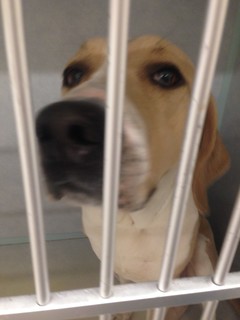

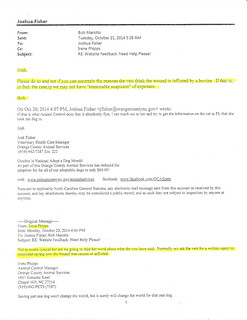

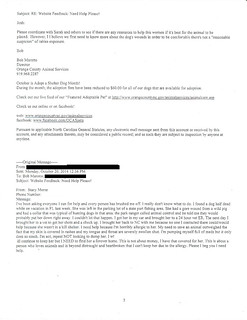

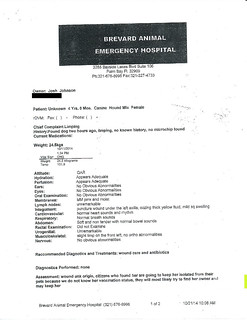
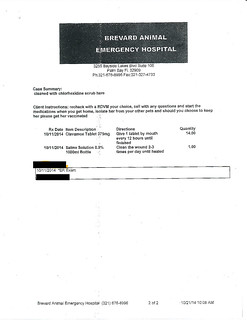
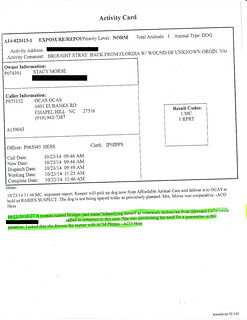

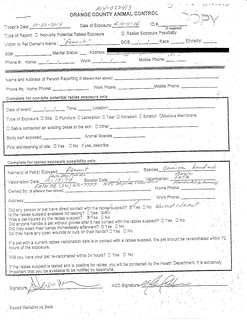


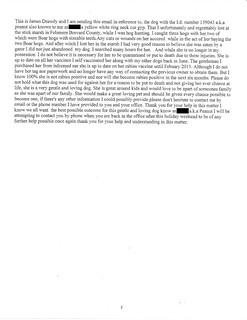
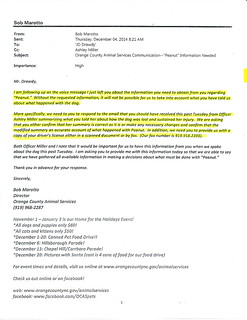

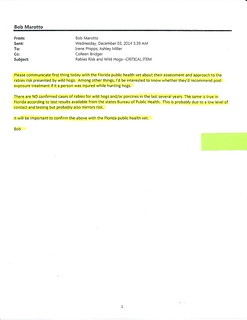
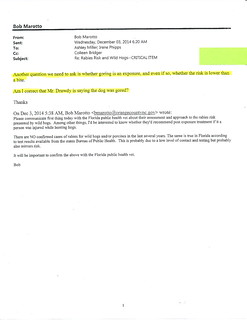
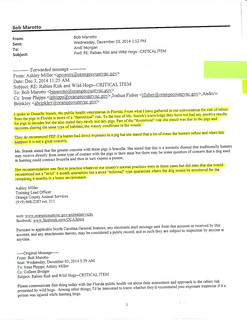

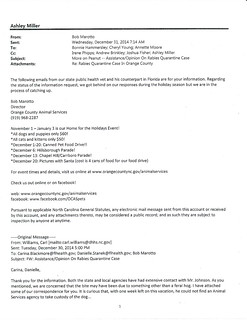

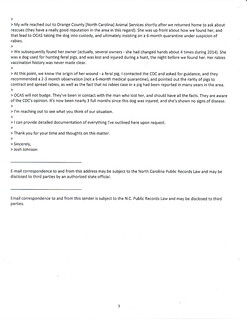
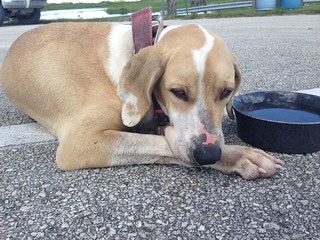
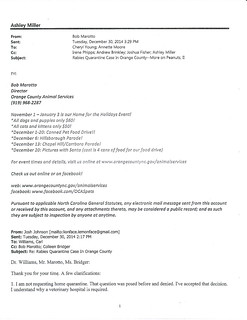
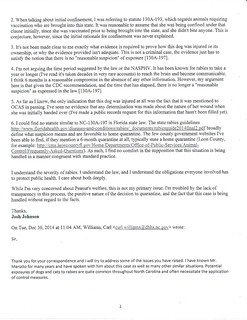


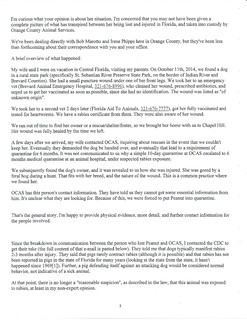
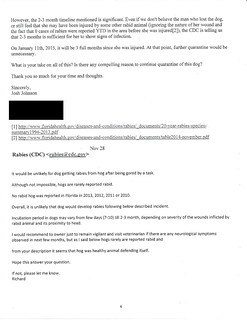
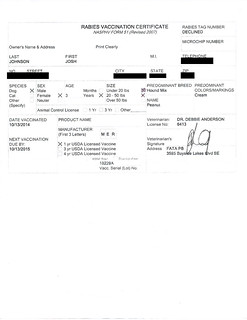

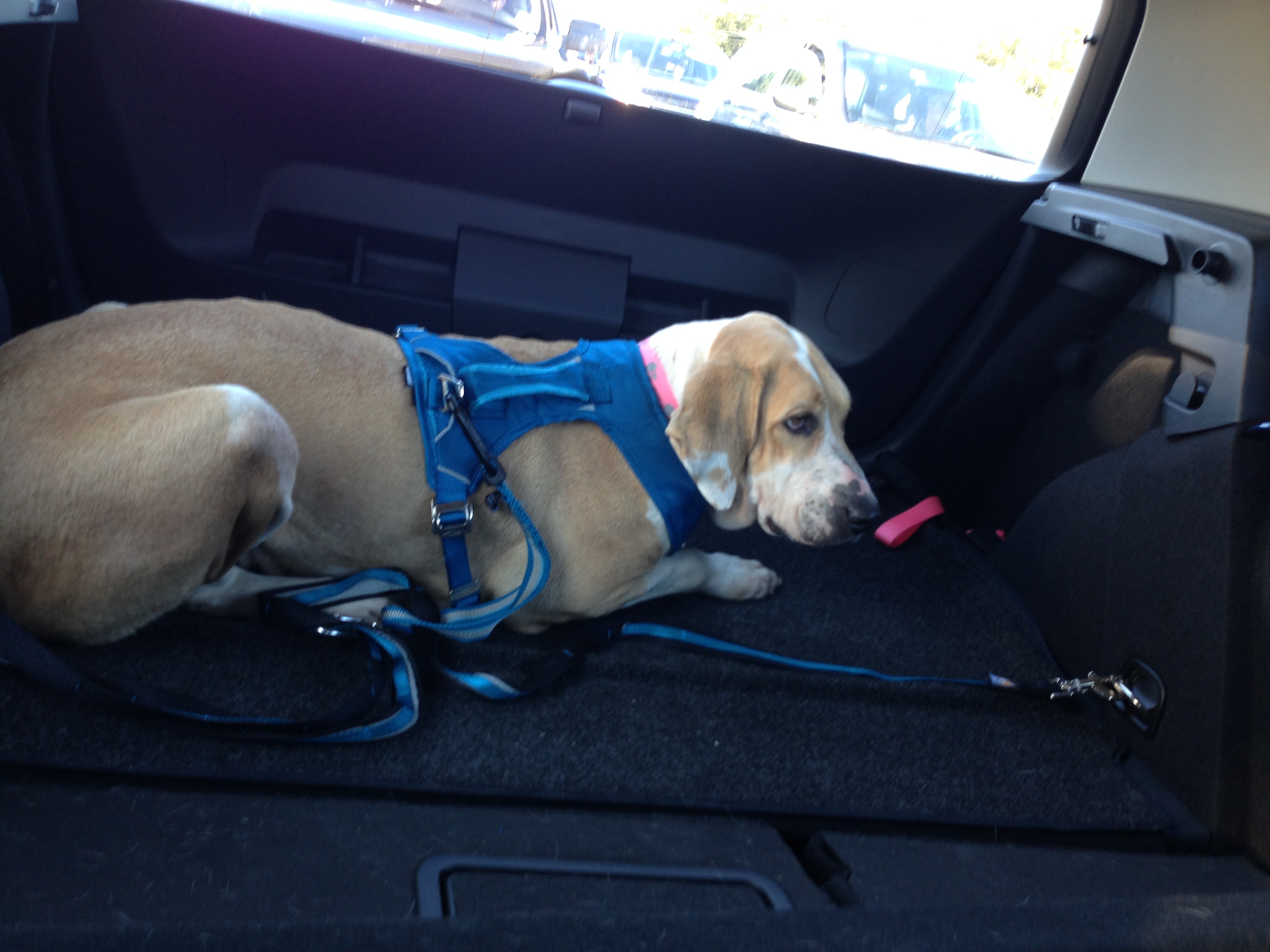
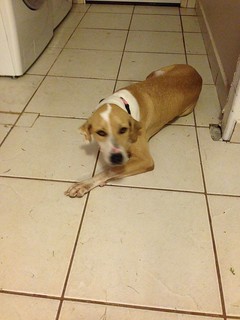
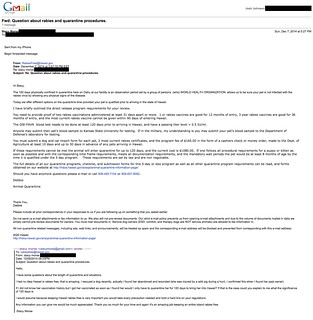
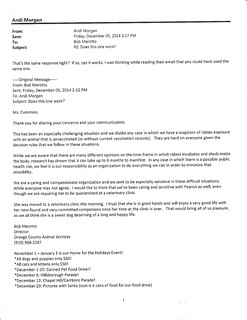
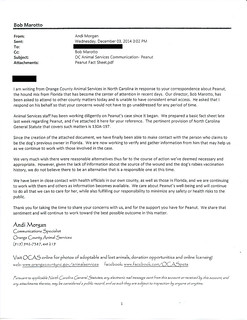
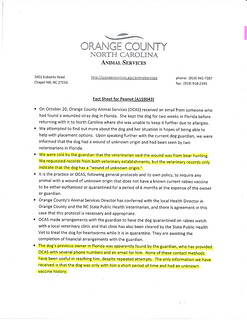
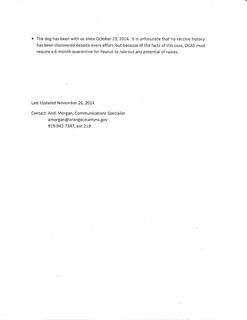
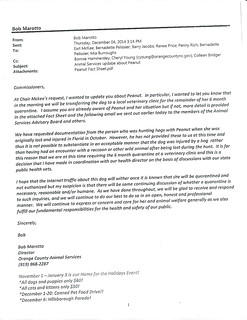

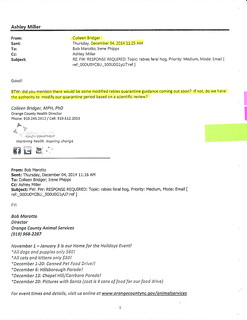
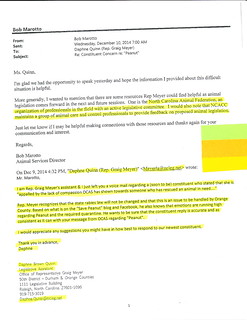
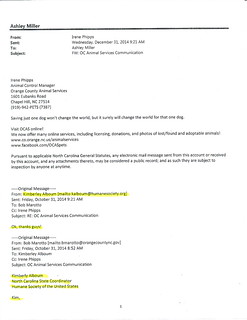
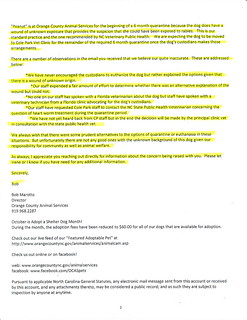

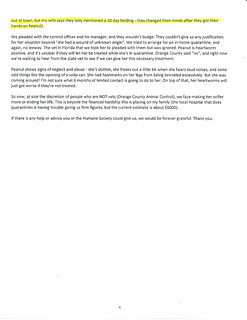
No comments:
Post a Comment